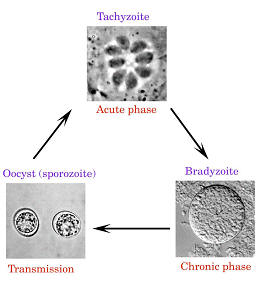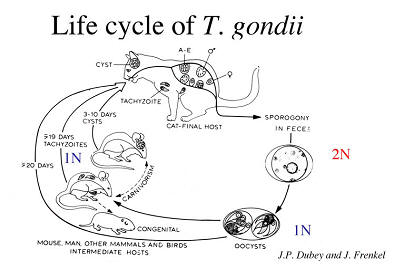

|
|
Life Cycle Toxoplasma gondii infects a variety of warm-blooded vertebrates where haploid stages undergo mitotic division. Acute infections are characterized by rapidly growing tachyzoites while chronic infections result from transformation into a semi-dormant form called the bradyzoite. When members of the cat family are infected, the parasite differentiates and |
|
||
 |
undergoes sexual recombination resulting in shedding of a diploid oocyst in the environment. The oocyst undergoes meiosis to yield eight haploid progeny known as sporozoites (Dubey and Frenkel 1972). Humans may become infected by ingesting oocysts, which contaminate the environment, or tissue cysts containing bradyzoites found in infected meat. Despite having meiosis in its life cycle, T. gondii maintains a clonal population structure. |
||
|
T. gondii has a complex nuclear genome and two organellar genomes. The life cycle of T. gondii has been used in the laboratory to cross strains experimentally and to perform linkage analysis. Some of the advantages of this classical genetics approach include: a relatively stable genome allows simple linkage analysis, production of a large number of distinct progeny, haploidy simplifies genetic typing, and allows direct observation of phenotypes, progeny can be cryo-preserved and analyzed at a later date. |
|||
Department of Molecular Microbiology
Washington University School of Medicine
St. Louis, MO USA

